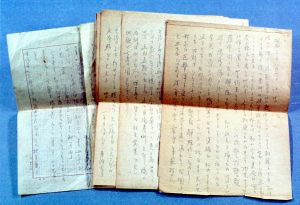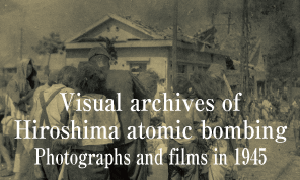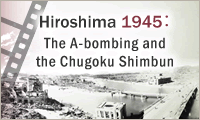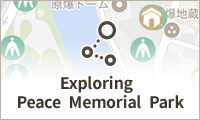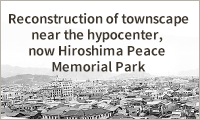A letter from Msashi Kurata’s mother, First year, class 2
Nov. 16, 1999
Masashi Kurata was in Class 2. On the front and back of eight sheets of rough paper, his mother Hatsune wrote down what she saw on the afternoon of August 6 at the site where Masashi had worked and the conversation she had with him before he died at home on August 7. Masashi’s cousin Michio Kurata keeps the notes. The following is part of them.
▼Notes written by Msashi Kurata’s mother
There were a few children wearing buttons of the Second Middle School lying on the ground around the east side of the bridge (Note: Shin-Ohashi Bridge near the site where the students worked), so I could tell roughly where they worked, but most of them were only wearing their trousers. Some of them were wearing only a belt. They were on the verge of death and crying for water. When I looked at the river from the bank, the river was full to its banks with gravely injured children, some leaning against rafts in the water and crying for help. The sight was so heartbreaking my heart was filled up with sorrow.
The tide was rising, and a military boat arrived. The voice of a soldier “Hang in there! We’ll save you!” sounded like the voice of a savior. The boat got to the bank, and planks were laid between the boat and the bank. When a soldier shouted, “Those who can walk, come on over,” the dying children staggered to their feet and moved forward, with the sole desire to be saved.
As the sun was setting, I called out, “Masashi! Masashi!” at the foot of the bridge, and suddenly I heard a voice saying “Mrs. Kurata.” I called out, “Who is it?” “Ouchi (Note: Shun Ouchi in Class 3),” he answered. I ran up to him, and it was indeed Ouchi. He was wearing black clothes, with his jacket and trousers still on, but he had no shoes on and pitiful injuries on his toes. (Omitted)
There was a student from Second Middle School lying on the ground just across the bridge. The name tag on his chest read “First Year, Class 2, Shindo.” I said to him, “Shindo.” “Yes.” “Pull yourself together.” “Please give me some water.” “Haven’t you seen Kurata?” “No, I haven’t.” I felt as if my faintest hope had been crushed. I stood surrounded by the dead and injured on the scorched ground stretching as far as I could see, and saw the western sky beginning to grow dark. Then a sense of loneliness welled up from the depths of my heart, and I found myself calling out my husband’s name (Note: He was doing his military service). (Omitted)
I walked home with a heavy step along the streetcar line. (Omission - She found Masashi being carried home on a wooden shutter). His face was covered in white ointment, and it was so swollen I could hardly recognize him. His lips were also swollen and turned up just like those of the children I saw at the school.
When I approached him and said, “Do you see? It’s your mom,” he replied clearly, “I do.” And he added, “Let’s go to a safer place, Mom.” “Oh, yes.” After a short while, he asked me, “Where shall we go, Mom?” I said, “I will come up with some ideas before your wounds heal, and then let’s go and live together.” He seemed satisfied with this. “Does it hurt?” “No.” “Is your chest painful?” “No.” He just said that it was hot. (The rest is omitted.)
This is a letter written by Koso Iwamoto, a student in Class 3, to his sister living in Asahara Village (Saeki Town) when he was living in a dormitory. This letter to his younger sister Yoshiko was written on the back of a can label, and she still keeps it. She was in the fourth grade of a national school (elementary school) at the time. The following is the letter in its original form.
▼Notes written by Msashi Kurata’s mother
There were a few children wearing buttons of the Second Middle School lying on the ground around the east side of the bridge (Note: Shin-Ohashi Bridge near the site where the students worked), so I could tell roughly where they worked, but most of them were only wearing their trousers. Some of them were wearing only a belt. They were on the verge of death and crying for water. When I looked at the river from the bank, the river was full to its banks with gravely injured children, some leaning against rafts in the water and crying for help. The sight was so heartbreaking my heart was filled up with sorrow.
The tide was rising, and a military boat arrived. The voice of a soldier “Hang in there! We’ll save you!” sounded like the voice of a savior. The boat got to the bank, and planks were laid between the boat and the bank. When a soldier shouted, “Those who can walk, come on over,” the dying children staggered to their feet and moved forward, with the sole desire to be saved.
As the sun was setting, I called out, “Masashi! Masashi!” at the foot of the bridge, and suddenly I heard a voice saying “Mrs. Kurata.” I called out, “Who is it?” “Ouchi (Note: Shun Ouchi in Class 3),” he answered. I ran up to him, and it was indeed Ouchi. He was wearing black clothes, with his jacket and trousers still on, but he had no shoes on and pitiful injuries on his toes. (Omitted)
There was a student from Second Middle School lying on the ground just across the bridge. The name tag on his chest read “First Year, Class 2, Shindo.” I said to him, “Shindo.” “Yes.” “Pull yourself together.” “Please give me some water.” “Haven’t you seen Kurata?” “No, I haven’t.” I felt as if my faintest hope had been crushed. I stood surrounded by the dead and injured on the scorched ground stretching as far as I could see, and saw the western sky beginning to grow dark. Then a sense of loneliness welled up from the depths of my heart, and I found myself calling out my husband’s name (Note: He was doing his military service). (Omitted)
I walked home with a heavy step along the streetcar line. (Omission - She found Masashi being carried home on a wooden shutter). His face was covered in white ointment, and it was so swollen I could hardly recognize him. His lips were also swollen and turned up just like those of the children I saw at the school.
When I approached him and said, “Do you see? It’s your mom,” he replied clearly, “I do.” And he added, “Let’s go to a safer place, Mom.” “Oh, yes.” After a short while, he asked me, “Where shall we go, Mom?” I said, “I will come up with some ideas before your wounds heal, and then let’s go and live together.” He seemed satisfied with this. “Does it hurt?” “No.” “Is your chest painful?” “No.” He just said that it was hot. (The rest is omitted.)
This is a letter written by Koso Iwamoto, a student in Class 3, to his sister living in Asahara Village (Saeki Town) when he was living in a dormitory. This letter to his younger sister Yoshiko was written on the back of a can label, and she still keeps it. She was in the fourth grade of a national school (elementary school) at the time. The following is the letter in its original form.

